BUICK PARK AVENUE 1993 Owners Manual
Manufacturer: BUICK, Model Year: 1993, Model line: PARK AVENUE, Model: BUICK PARK AVENUE 1993Pages: 340, PDF Size: 18.17 MB
Page 251 of 340
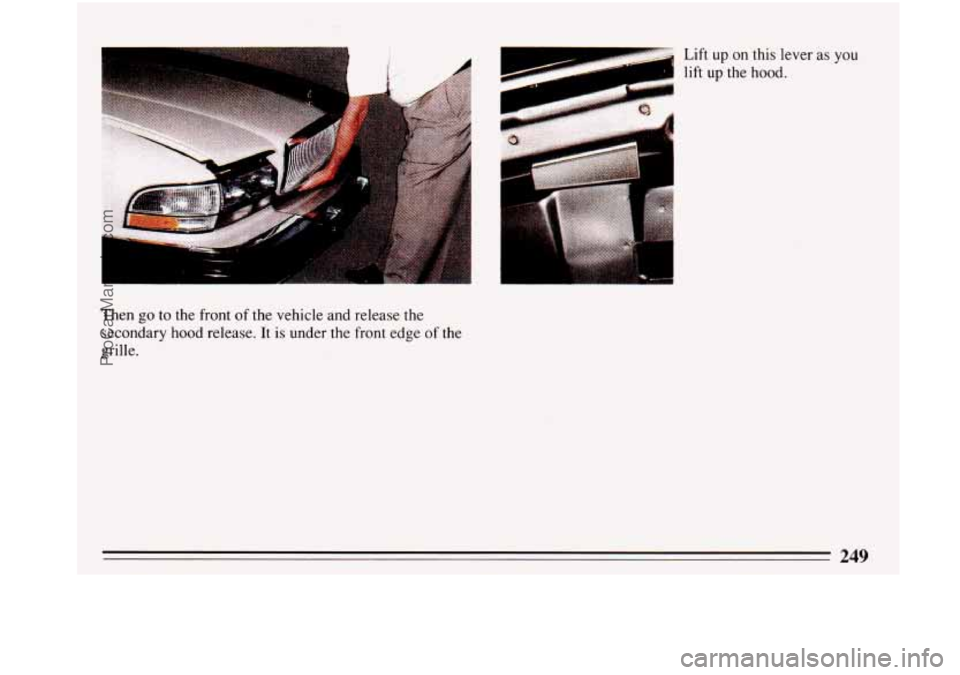
Then go to the front of the vehicle and release the
secondary hood release. It is under the front edge of the
grille.
L
ProCarManuals.com
Page 252 of 340
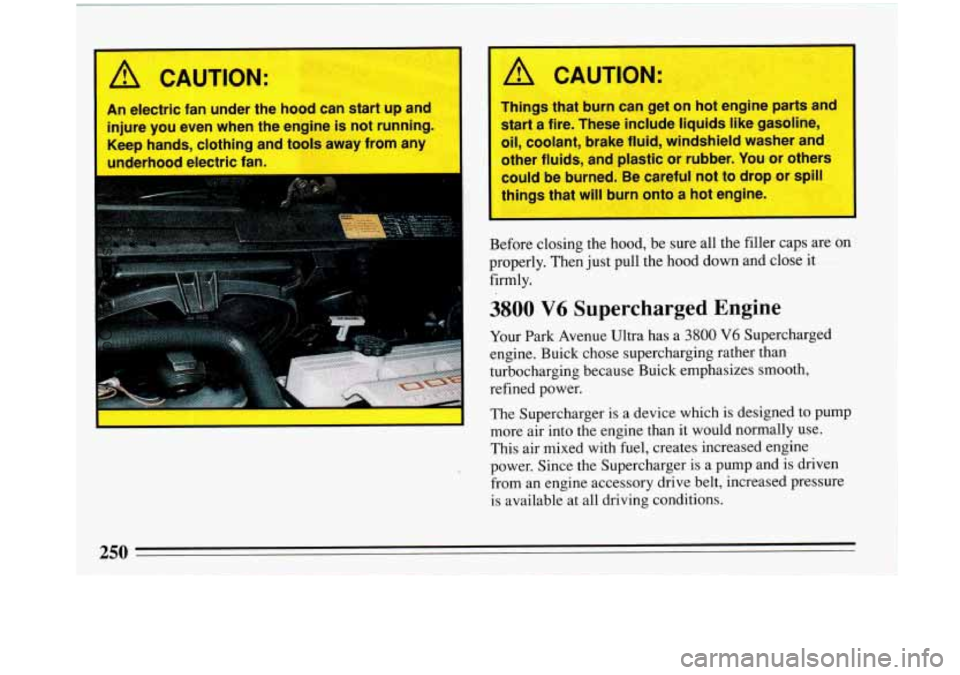
A CAUTION:
An electric fan under the hood can start up and
injure you even when the engine is not running.
Keep hands, clothing and tools away from any
I underhood electric fan. I
A CAUTION:
1
Things that burn can get on hot engine parts and
start a fire. These include liquids like gasoline,
oil, coolant, brake fluid, windshield washer and
other fluids, and plastic or rubber.
You or others
could be burned. Be careful not to drop or spill
things that will burn onto
a hot engine.
-- I
Before closing the hood, be sure all the filler caps are on
properly. Then just pull the hood down and close it
firmly.
3800 V6 Supercharged Engine
Your Park Avenue Ultra has a 3800 V6 Supercharged
engine. Buick chose supercharging rather than
turbocharging because Buick emphasizes smooth,
refined power.
The Supercharger is a device which is designed
to pump
more air into the engine than it would normally use.
This air mixed with fuel, creates increased engine
power. Since the Supercharger is a pump and
is driven
from an engine accessory drive belt, increased pressure
is available at all driving conditions.
250
ProCarManuals.com
Page 253 of 340
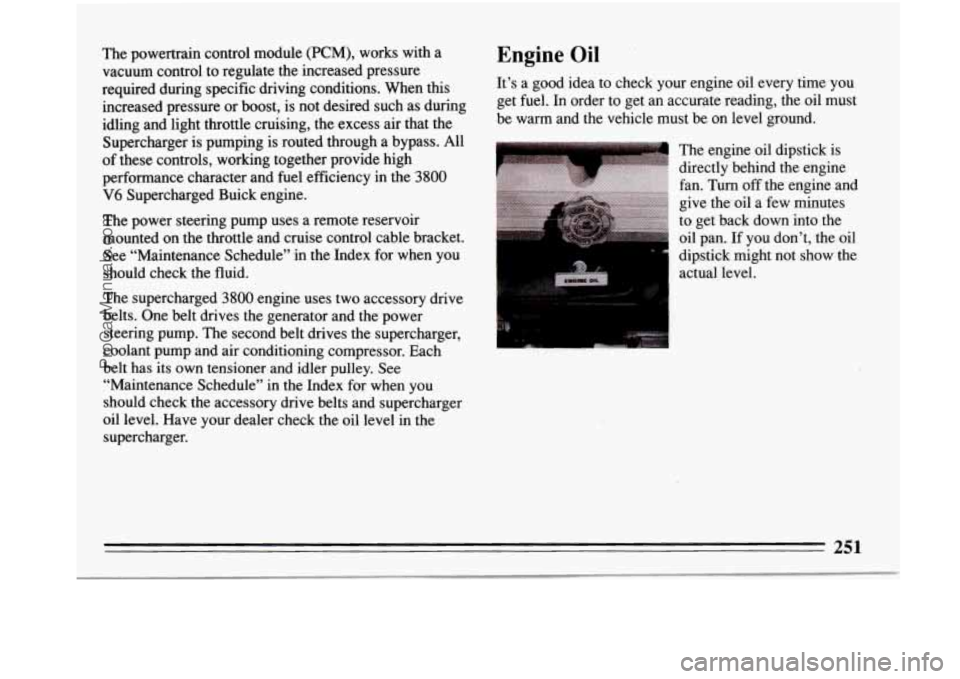
The powertrain control module (PCM), works with a
vacuum control to regulate the increased pressure
required during specific driving conditions. When this
increased pressure or boost, is not desired such as during
idling and light throttle cruising, the excess air that the
Supercharger is pumping is routed through a bypass. All
of these controls, working together provide high
performance character and fuel efficiency in the
3800
V6 Supercharged Buick engine.
The power steering pump uses a remote reservoir
mounted on the throttle and cruise control cable bracket.
See “Maintenance Schedule’’ in the Index for when you
should check the fluid.
The supercharged
3800 engine uses two accessory drive
belts. One belt drives the generator and the power
steering pump. The second belt drives the supercharger,
coolant pump and air conditioning compressor. Each
belt has
its own tensioner and idler pulley. See
“Maintenance Schedule’’ in the Index for when you
should check the accessory drive belts and supercharger
oil level. Have your dealer check the oil level in the
supercharger.
Engine Oil
It’s a good idea to check your engine oil every time you
get fuel. In order to get an accurate reading, the oil must
be warm and the vehicle must be on level ground.
The engine oil dipstick is
directly behind the engine
fan. Turn
off the engine and
give the oil a few minutes
to get back down into the
oil pan. If you don’t, the oil
dipstick might not &ow the
actual level.
ProCarManuals.com
Page 254 of 340
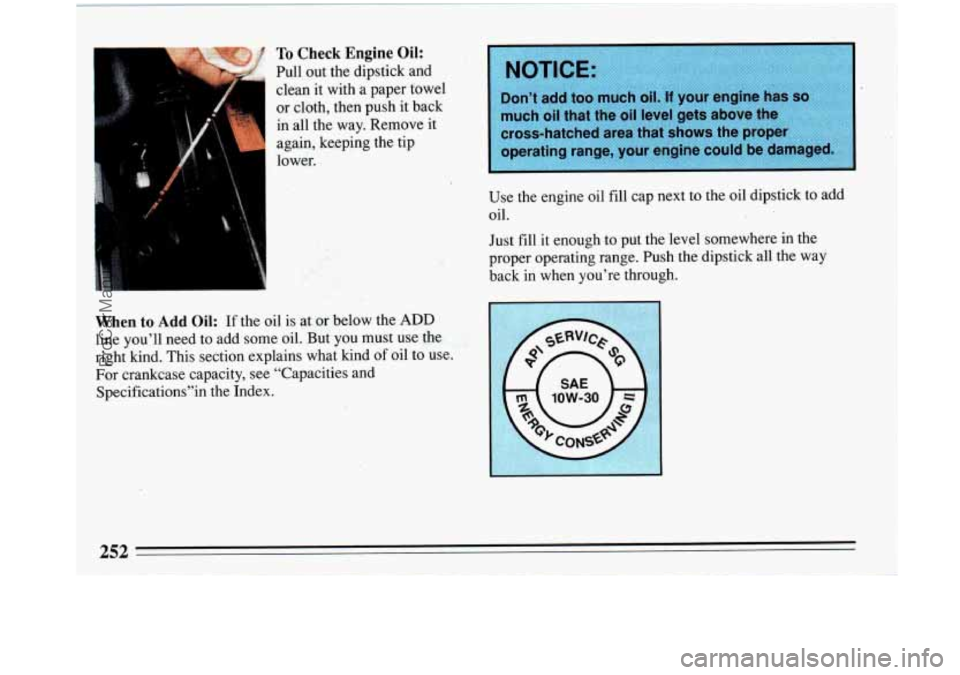
To Check Engine Oil:
Pull out the dipstick and
clean it with a paper towel
or cloth, then push it back
in all the way. Remove it
again, keeping the tip
lower.
I
i
When to Add Oil: If the oil is at or below the ADD
line you’ll need to add some oil. But you must use the
right kind. This section explains what kind of oil to use.
For crankcase capacity, see “Capacities and
Specifications”in the Index.
I NOTICE:
Don’t add too much oil. If your engine has so
much oil that the oil level gets above the
cross-hatched area that shows the proper operating range, your engine could be damaged,
Use the engine oil fill cap next to the oil dipstick to add
oil.
Just
fill it enough,to put the level somewhere in the
proper operating range. Push the-dipstick all the way
back in when you’re through.
252
ProCarManuals.com
Page 255 of 340
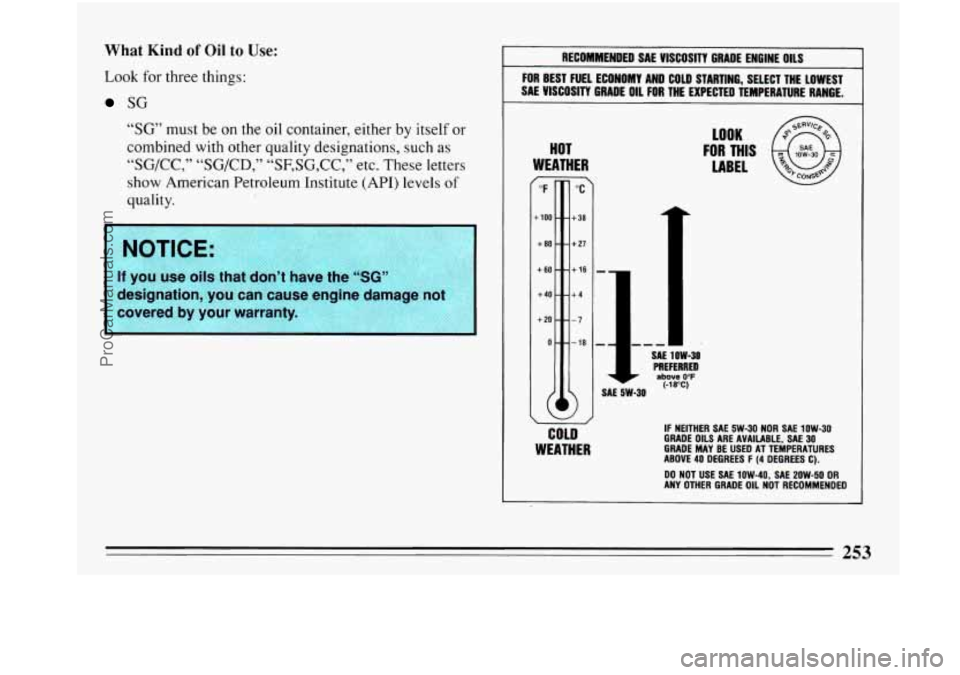
What Kind of Oil to Use:
Look for three things:
SG
“SG” must be on the oil container, either by itself or
combined with other quality designations, such as
“SG/CC,” “SG/CD,” “SF,SG,CC,” etc. These letters
show American Petroleum Institute (API) levels of
quality.
If you use oils that don’t have the “SG”
designation,
you can cause engine damage not I
covered by your warranty.
I
RECOMMENDED SAE VISCOSITY GRADE ENGINE OILS
FOR BEST FUEL ECONOMY AND COLD STARTING, SELECT THE LOWEST
SAE VISCOSITY GRADE
OIL FOR THE EXPECTED TEMPERATURE RANGE.
HOT
WEATHER
-
-
SAE 5W-30
LOOK
FOR THIS
LABEL
SAE 1OW-30
PREFERRED
above 0°F (-18%)
COLD
WEATHER
IF NEITHER SAE 5W-30 NOR SAE 1OW-30
GRADE OILS ARE AVAILABLE, SAE 30
GRADE MAY BE USED AT TEMPERATURES
ABOVE 40 DEGREES
F (4 DEGREES C).
ANY OTHER GRADE OIL NOT RECOMMENDED
DO
NOT USE SAE 1OW-40, SAE 2OW-50
OR
ProCarManuals.com
Page 256 of 340
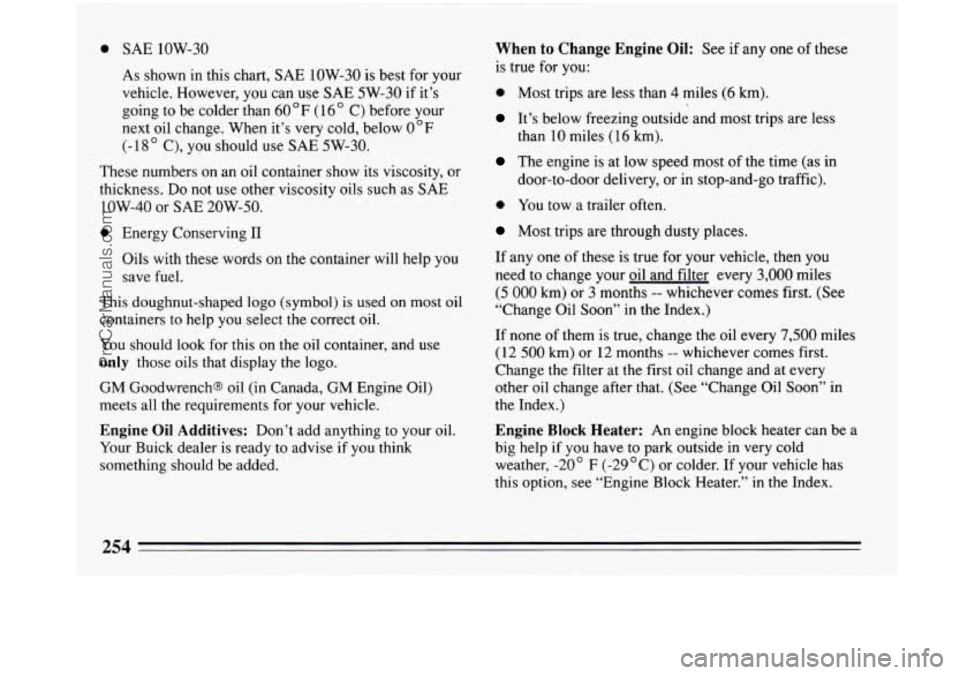
0 SAE low-30
As shown in this chart, SAE 1OW-30 is best for your
vehicle. However, you can use
SAE 5W-30 if it’s
going to be colder than
60 OF (1 6 ” C) before your
next oil change. When it’s very cold, below
0°F
(- 18 ” C), you should use SAE 5W-30.
These numbers on an oil container show
its viscosity, or
thickness. Do not use other viscosity oils such as SAE
low-40 or SAE 20W-50.
0 Energy Conserving I1
Oils with these words
on the container will help you
save
fuel.
This doughnut-shaped logo (symbol) is used on most oil
containers to help you select the correct oil.
You should look for this on
the oil container, and use
only those oils that display the logo.
GM Goodwrench@ oil (in Canada, GM Engine Oil)
meets all the requirements for your vehicle.
Engine Oil Additives: Don’t add anything to your oil.
Your Buick dealer is ready
to advise if you think
something should be added.
When to Change Engine Oil: See if any one of these
is true for
you:
0 Most trips are less than 4 miles (6 km).
It’s below freezing outside and most trips are less
The engine is at low speed most of the time (as in
door-to-door delivery, or in stop-and-go traffic).
0 You tow a trailer often.
than
10 miles
(16 km).
Most trips are through dusty places.
If any one of these is true for your vehicle, then
you
need to change your oil and filter every 3,000 miles
(5 000 km) or 3 months -- whichever comes first. (See
“Change Oil Soon” in the Index.)
If none of them is true, change the oil every 7,500 miles
(12 500 km) or 12 months -- whichever comes first.
Change
the filter at the first oil change and at every
other oil change after that. (See “Change
Oil Soon” in
the Index.)
Engine Block Heater: An engine block heater can be a
big help
if you have to park outside in very cold
weather,
-20” F (-29 “C) or colder. If your vehicle has
this option, see “Engine Block Heater.”
in the Index.
ProCarManuals.com
Page 257 of 340
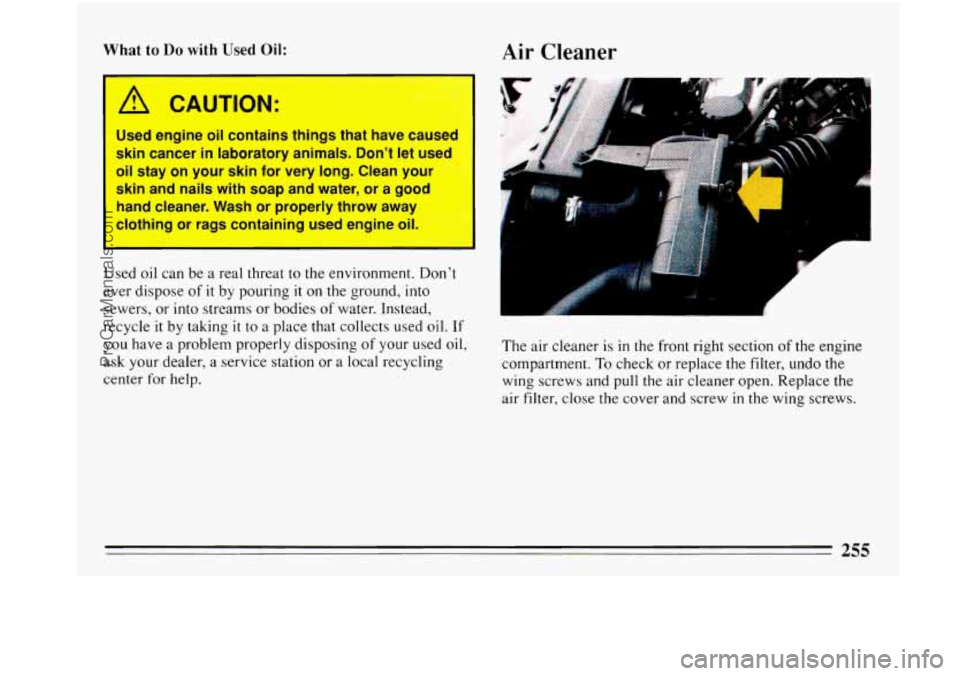
What to Do with Used Oil:
A CAUTION:
Used engine oil contains things that have cause
skin cancer in laboratory animals. Don't let used
oil stay on your skin for very long. Clean your
skin and nails with soap and water, or a good
hand cleaner. Wash or properly throw away
clothing or rags containing used engine
0"
Used oil can be a real threat to the environment. Don't
ever dispose of
it by pouring it on the ground, into
sewers,
or into streams or bodies of water. Instead,
recycle
it by taking it to a place that collects used oil. If
you have a problem properly disposing of your used oil,
ask your dealer, a service station or a local recycling
center for help.
I
Air Cleaner
The air cleaner is in the front right section of the engine
compartment. To check or replace the filter, undo the
wing screws and pull the air cleaner open. Replace the
air filter, close the cover and screw
in the wing screws.
ProCarManuals.com
Page 258 of 340
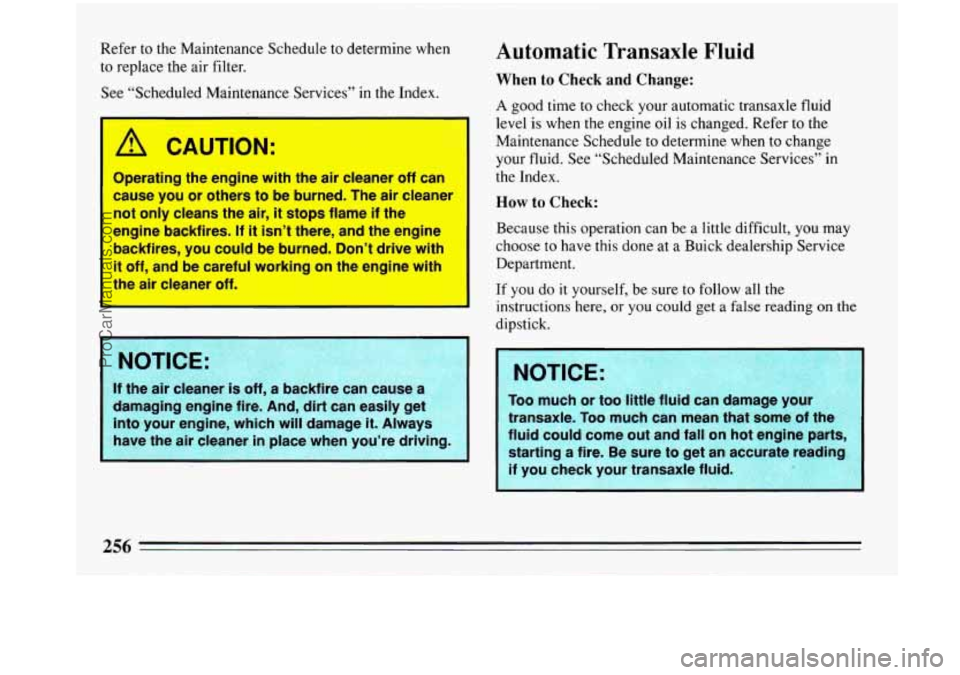
Refer to the Maintenance Schedule to determine when
to replace the air filter.
See “Scheduled Maintenance Services’’ in the Index.
A CAUTION:
Operating the engine with the air cleaner off can
cause you or others to be burned. The air cleaner
not only cleans the air, it stops flame
if the
engine backfires.
If it isn’t there, and the engine
backfires, you could be burned. Don’t drive with
it off, and be careful working on the engine with
the air cleaner off.
: NOTICE:
I If the air clean
i damaging engine fire. And, dirt can easily get
into your engine, which will damage
it. Always
’ have the air cleaner in place when you’re driving.
Automatic Transaxle Fluid
When to Check and Change:
A good time to check your automatic transaxle fluid
level is when the engine oil is changed. Refer to the
Maintenance Schedule to determine when to change
your fluid. See “Scheduled Maintenance Services” in
the Index.
How to Check:
Because this operation can be a little difficult, you may
choose to have this done at a Buick dealership Service Department.
If
you do it yourself, be sure to follow all the
instructions here, or
you could get a false reading on the
dipstick.
transaxle. Too much can mean that some of the
fluid could come out and fall on hot engine parts,
starting a fire. Be sure to get an
a
if you check your transaxle fluid.
ProCarManuals.com
Page 259 of 340
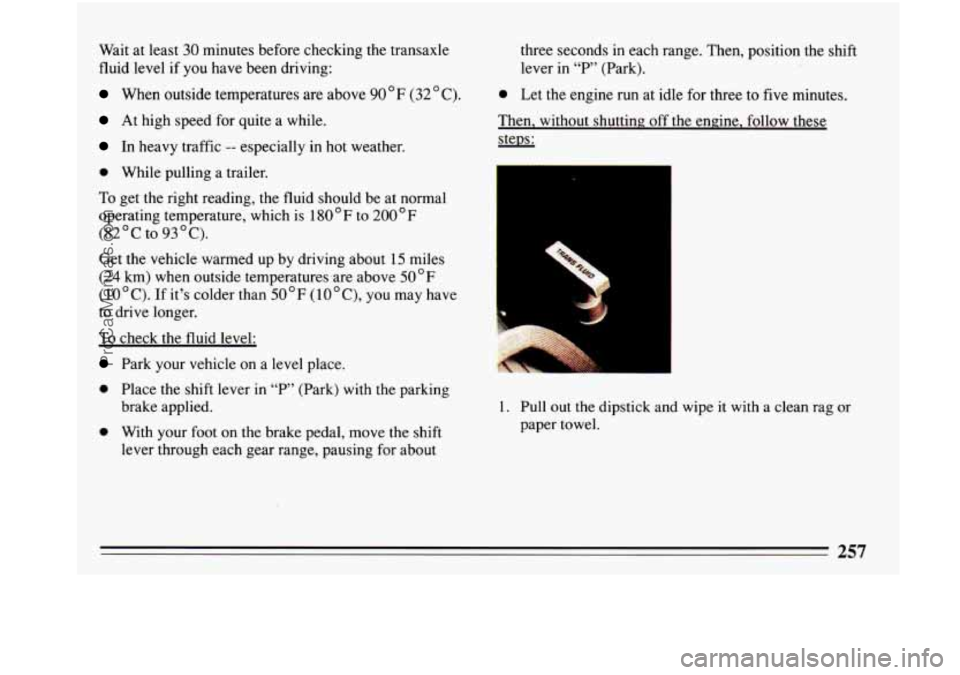
Wait at least 30 minutes before checking the transaxle
fluid level if you have been driving:
When outside temperatures are above 90°F (32 C).
At high speed for quite a while.
In heavy traffic -- especially in hot weather.
0 While pulling a trailer.
To get the right reading, the fluid should be at normal
operating temperature, which is
1 80 F to 200 F
(82OC to 93OC).
Get
the vehicle warmed up by driving about 15 miles
(24 km) when outside temperatures .are above
50 F
(10OC). If it’s colder than 50°F (lO°C), you may have
to drive longer.
To check the fluid level:
Park your vehicle on a level place.
0 Place the shift lever in “P’ (Park) with the parking
brake applied.
0 With your foot on the brake pedal, move the shift
lever through each gear range, pausing for about three seconds
in each range. Then, position the shift
lever
in “P’ (Park).
0 Let the engine run at idle for three to five minutes.
Then, without shutting off the engine, follow these
steps:
1. Pull out the dipstick and wipe it with a clean rag or
paper towel.
ProCarManuals.com
Page 260 of 340
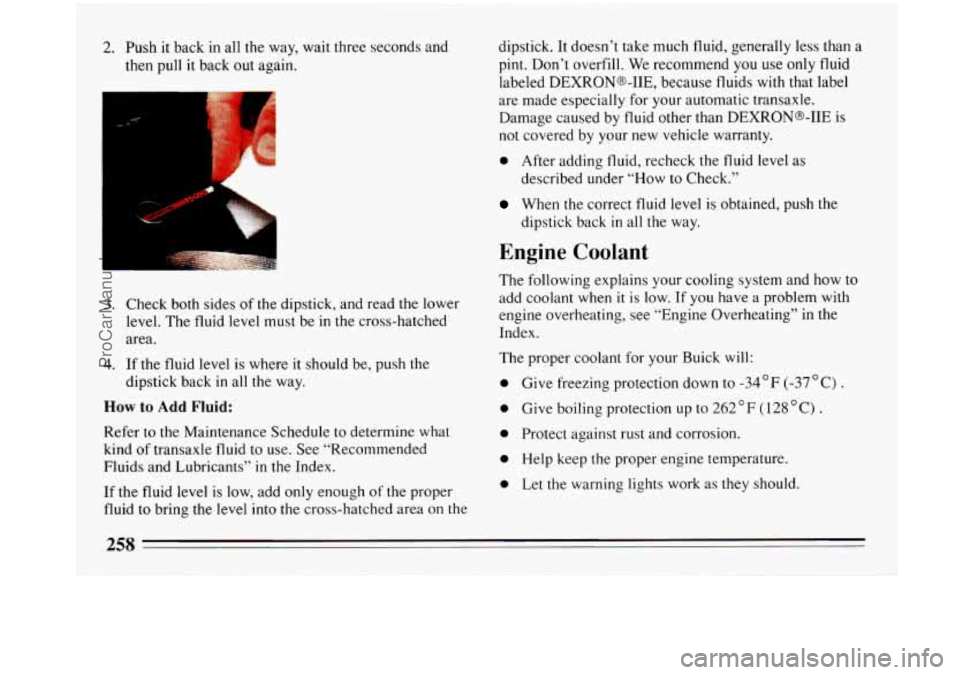
2. Push it back in all the way, wait three seconds and
then pull it back out again.
3. Check both sides of the dipstick, and read the lower
level. The fluid level must be in the cross-hatched
area.
4. If the fluid level is where it should be, push the
dipstick back
in all the way.
How to Add Fluid:
Refer to the Maintenance Schedule to determine what
kind of transaxle fluid to use. See “Recommended
Fluids and Lubricants” in the Index.
If the fluid level is low, add only enough of the proper
fluid to bring the level
into the cross-hatched area on the dipstick, It
doesn’t take much fluid, generally less than a
pint. Don’t overfill. We recommend
you use only fluid
labeled DEXRONWIE, because
fluids with that label
are made especially for your automatic transaxle.
Damage caused by fluid other than DEXRONB-IIE is
not covered by your new vehicle warranty.
0 After adding fluid, recheck the fluid level as
described under “How to Check.”
When the correct fluid level is obtained, push the
dipstick back
in all the way.
Engine Coolant
The following explains your cooling system and how to
add coolant when
it is low. If you have a problem with
engine overheating, see “Engine Overheating” in the
Index.
The proper coolant for your Buick will:
0 Give freezing protection down to -34°F (-37 “C) .
0 Give boiling protection up to 262 F ( 128 ” C) .
0 Protect against rust and corrosion.
0 Help keep the proper engine temperature.
0 Let the warning lights work as they should.
ProCarManuals.com